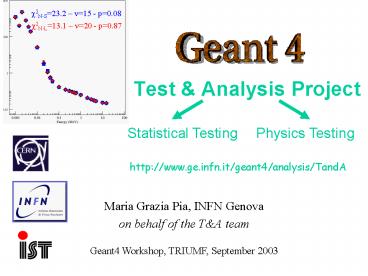Test PowerPoint PPT Presentation
1 / 62
Title: Test
1
Test Analysis Project
?2N-S23.2 ?15 - p0.08
?2N-L13.1 ?20 - p0.87
Statistical Testing
Physics Testing
http//www.ge.infn.it/geant4/analysis/TandA
- Maria Grazia Pia, INFN Genova
- on behalf of the TA team
Geant4 Workshop, TRIUMF, September 2003
2
Physics Testing Project
- Electromagnetic Physics
3
Process
- Iterative and incremental, RUP-based
- Vision
- start with an initial set of basic
electromagnetic tests - use GoF component of HEPstatistics
- produce meaningful physics results
- role in physics and regression testing
- First cycle
- geant4/tests/test50
- simple design (design iteration foreseen in near
future) - first set of meaningful results
4
Main User Requirements
- The test produces typical distributions of
physical quantities of interest for testing a set
of physical processes. - The user shall be able to define electrons,
positrons, antiprotons, pions, photons, ions. - The experimental set-up (e.g.absorber size and
material) can be changed by the user. - The user shall be able to define position,
direction, energy of primary particles. - The user shall be able to define electromagnetic
and hadronic processes. - The user shall be able to choose different e.m.
G4 Packages (Standard, LowE, Penelope) - The user shall be able to switch on/off the
individual physics processes. - URD in http//www.ge.infn.it/geant4/analysis/test
5
Test Design
6
Physics Tests
- Particle CSDA range
- Particle Stopping Power
- Transmission coefficient
- Backscattering coefficient
- Photon Attenuation coefficient
- Cross sections
- Particle range
- Bremsstrahlung energy spectrum
- Multiple scattering distributions
- Energy deposit in absorber
- Bragg peak (including hadronic interactions)
- etc.
- ?
7
Test results
Photon attenuation
coefficient -ln ( gammaTransmittedFraction /
(targetThickness absorberDensity) )
Absorber Materials Be, Al, Si, Ge, Fe, Cs, Au,
Pb, U
8
X-ray Attenuation Coefficient - Al
9
X-ray Attenuation Coefficient - Al
?2N-P15.9 ?19 p0.66
10
X-ray Attenuation Coefficient - Ge
11
X-ray Attenuation Coefficient - Ge
?2N-P10.1 ?21 - p0.98
12
X-ray Attenuation Coefficient - U
13
X-ray Attenuation Coefficient - U
?2N-P19.3 ?22 - p0.63
14
Test results
Photon cross sections attenuation coefficients
with only one process activated
Absorber Materials Be, Al, Si, Ge, Fe, Cs, Au,
Pb, U
15
Compton Scattering - Al
16
Compton Scattering - Al
?2N-P2.5 ?6 - p0.87
17
Compton Scattering - Cs
18
Compton Scattering - Cs
?2N-P4.6 ?8 - p0.80
19
Rayleigh Scattering - Al
?2N-L13.6 ?11 - p0.26
20
Rayleigh Scattering - Al
?2N-P7.2 ?8 - p0.52
21
Rayleigh Scattering - Cs
22
Raleygh Scattering - Cs
23
Photoelectric Effect - Fe
24
Photoelectric effect - Fe
25
Photoelectric Absorption - Ge
2 compatible Monte Carlo are not necessarily the
Truth!
26
Pair Production - Si
27
Pair Production Si
28
Test results
CSDA range and Stopping Power for electrons
- no multiple scattering - no energy
fluctuations
Absorber Materials Be, Al, Si, Ge, Fe, Cs, Au,
Pb, U
29
CSDA Range - Al
30
CSDA Range - Pb
31
Stopping Power - Al
32
Stopping Power - Pb
33
CSDA Range Al G4LowE
Regression testing
34
CSDA Range Pb G4Standard
Regression testing
35
Test results
CSDA range and Stopping Power for protons
- no multiple scattering - no energy
fluctuations
Absorber Materials Be, Al, Si, Ge, Fe, Cs, Au,
Pb, U
36
CSDA Range Al
37
CSDA Range Al
38
CSDA Range Pb
39
Stopping Power Al
40
Stopping Power Pb
41
CSDA Range Al G4LowE
Regression testing
42
CSDA Range Al G4LowE Ziegler
Regression testing
43
CSDA Range Al G4Standard
Regression testing
44
CSDA Range Pb G4LowE
Regression testing
45
CSDA Range Pb G4LowE Ziegler
Regression testing
46
CSDA Range Pb G4Standard
Regression testing
47
Test results
Transmission
48
(No Transcript)
49
Angular distribution of transmitted electrons
50
Angular distribution of transmitted protons
51
Test results
Backscattering for electrons and positrons
Absorber Materials Be, Al, Si, Ge, Fe, Mg, Ag,
Au
52
Backscattering coefficient E100keV
Angle of incidence (with respect to the normal to
the sample surface) 0
53
Backscattering coefficient E1MeV
Angle of incidence (with respect to the normal to
the sample surface)0
54
Backscattering low energies - Au
Note experimental data often exhibit large
differences!
55
Backscattering low energies - Al
56
Backscattering low energies - Si
57
Backscattering coefficient 30keV
58
(No Transcript)
59
Test results Bragg peak, protons
Absorber Material water
Geant4-05-00
Comparison with experimental data from INFN,
LNS Catania
e.m. Physics
60
Status and plans
Present situation
- A set of basic e.m. tests and results is
available - CSDA range, stopping power, transmission,
backscattering, Bragg Peak, angular distributions
etc. - Regression tests
- already done twice
- Evaluation of the computing resources needed
- see Sandras talk in parallel session
Plans
- Integration in the Geant4 general system testing
- Design iteration
- Complete test automation
- Extend test coverage
- e.m processes for ions, muons, atomic relaxation,
add other e.m. physics distributions... - hadronic physics
- Use more sophisticated algorithms of the GoF
component
61
Conclusions
- A lot of progress since last years workshop...
- a lot of work, but also a lot of fun!
- A group of bright, enthusiastic, hard-working
young collaborators... - Ground for Geant4 Physics Book
62
More at IEEE-NSS, Portland, 19-25 October
2003 B. Mascialino et al., A Toolkit for
statistical data analysis L. Pandola et
al., Precision validation of Geant4
electromagnetic physics

